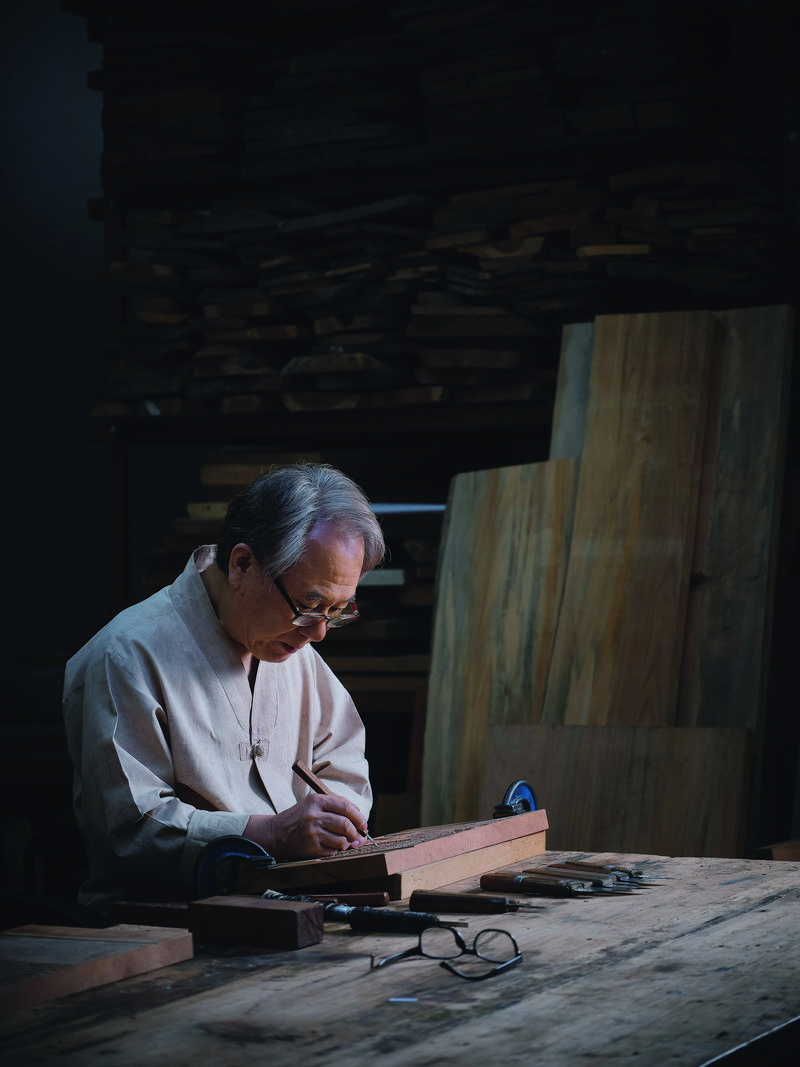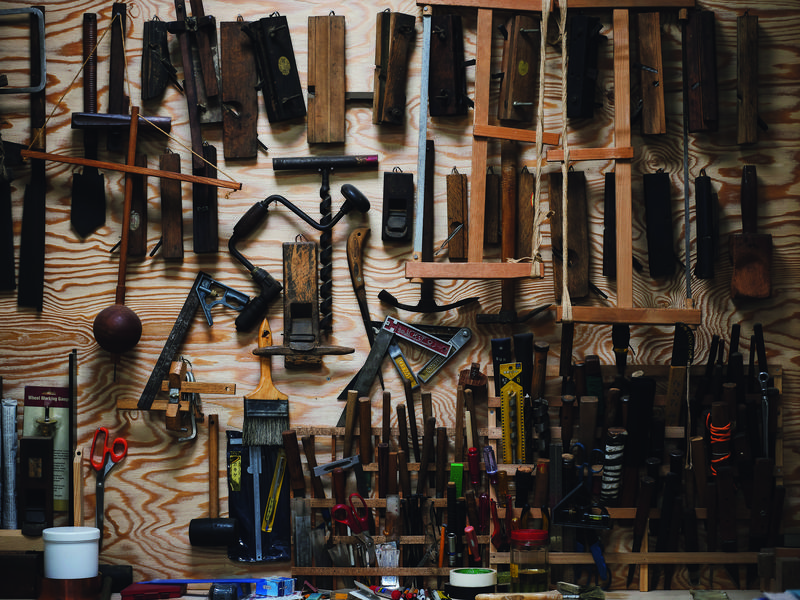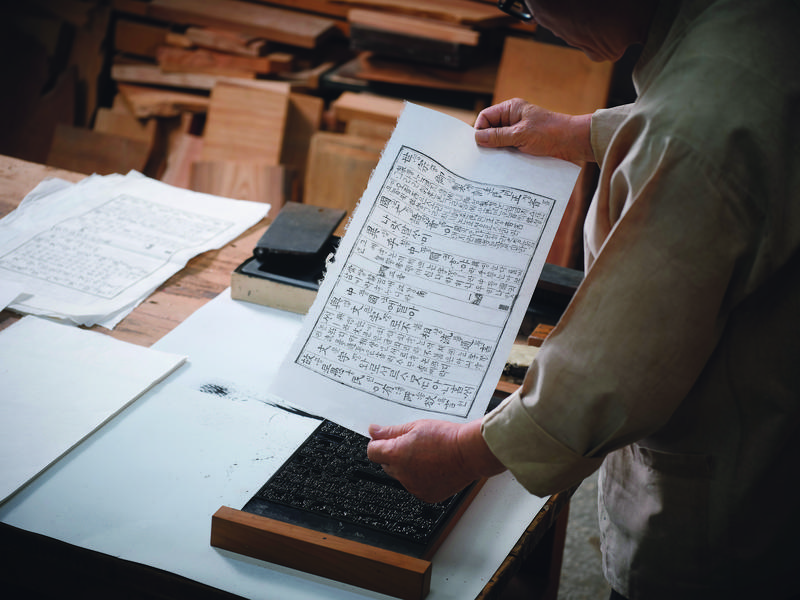Calligraphic engraving, or
gakja, a technique of carving letters and drawings on wooden boards, is an essential skill used for both woodblock printing and the production of signboards in traditional architecture. Gakja requires a comprehensive understanding of individual penmanship as well as the content of the respective texts. In recognition of his long-term dedication to the craft and its transmission, Kim Gak-han was designated as a holder of National Intangible Cultural Heritage in calligraphic engraving in 2013.

Kim Gak-han, a master calligraphy engraver, works on one of his projects. When carving woodblocks for book printing, he uses Sargent’s cherry tree wood which is known for its dense and moderately hard texture.
Calligraphic engraving, or gakja, refers to the age-old craft of carving letters and drawings on wooden boards. Throughout the long history of Korean culture, gakja has been used to produce woodblock prints as well as the signboards that hang on traditional buildings. An artisan who has practiced the craft for decades, Kim Gak-han was designated as holder of National Intangible Cultural Heritage in 2013. The master calligraphy engraver (gakjajang) has participated in the restoration of significant cultural heritage items: the signboard of Sungnyemun, one of Seoul’s historic gates which was partially lost to arson in 2008; the woodblock version of Anthology of Great Buddhist Priests’ Teachings (Jikji simche yojeol, 1377), known as the world’s earliest book printed using metal type; and the woodblocks for the printing of Explanation of the Korean (Hunminjeongeum eonhaebon, 1459), which was destroyed by fire during the Korean War.
WOODCRAFT TO ENGRAVING

An assortment of tools is needed for engraving intricate letters onto hard woodblocks. The artist uses more than 30 items, including hammers, knives, and chisels, among others.
Kim began his career as a woodworker. Born in 1957 to a farming family in Gimcheon, North Gyeongsang Province, he was the fifth child among five sons and a daughter. Kim barely finished elementary school and, upon his father’s passing when he was in sixth grade, he had to give up on attending middle school. Even at such an early age, he began learning woodworking at a local carpentry workshop in downtown Gimcheon.
Kim said, “As a child, I loved creating things with my hands. There were trees everywhere in my village, so I could learn early how to work with wood.”
Despite his disadvantageous circumstances, Kim yearned to continue his formal education so much that he worked during the day and studied at night, eventually passing the exams for middle and high school equivalency diplomas. After completing his compulsory military service, he moved to Seoul and attended a woodworking school near Tapgol Park in Jongno District. In 1983, his life took a dramatic turn when he visited an exhibition at the Dongduk Art Gallery showcasing the work of engraver Oh Ok-jin.
Kim recalled, “I came across traditional calligraphy engraving for the first time in my life. I instantly fell in love with the restored woodblock of the map of old Seoul, the Comprehensive Map of the Capital (Suseon jeondo). Soon after, I wrapped up the work I had been doing and sought out the master in order to learn from him.”
Kim’s teacher Oh Ok-jin was the first artisan to be named master calligraphy engraver after the craft became designated as National Intangible Heritage in 1996. In 2005, Kim became an assistant instructor for successor training and, eight years later, he succeeded his mentor as the second holder of the master craftsman title in recognition of his achievements in the restoration and transmission of heritage. While meeting Oh Ok-jin doubtlessly helped him steer his career from woodworking toward the traditional craft, it was calligrapher Park Chung-sik who led Kim onto the path of being a true craftsman.
Kim said, “In about two years after beginning to learn the craft, I realized the importance of gaining a deeper understanding of classical Chinese characters. As the craft dealt with a written language, I believed I wouldn’t be able to refine my artistry without proper knowledge of the medium, including its characters and writings.”
Having decided to learn calligraphy in earnest, Kim relocated to a neighborhood in the vicinity of his teacher’s studio in Bangbae-dong in southern Seoul. The small space he moved into has remained his workshop to this day. He also decided to continue his education by enrolling in the Chinese Language and Literature program at Korea National Open University in 1992. Embarking on this academic pursuit at such a mature age brought him an immense sense of joy in the learning process. The reality of having to juggle work and education meant it took him six years to finish the degree, and even now he continues to study Chinese characters.
WOOD TREATMENT TO PRINTING
The most fundamental aspect of calligraphic engraving is surely the act of carving itself, but it is in no way an exaggeration to say that the craft starts and ends with wood. Crucial here is what is known as chimok, or wood treatment, which involves procuring the right type of wood and subjecting it to a lengthy process of drying and aging.
Kim explained, “For signboards, I handle various tree species depending on the use, including sand pear (Pyrus pyrifolia) and pine. For woodblocks used for printing books, on the other hand, the Sargent’s cherry (Prunus sargentii) is considered most suitable, as its wood provides a dense and moderately hard texture.” According to Kim, an analysis of the wood species used for the printing blocks of the Tripitaka Koreana (Palman daejanggyeong) revealed that over 70 percent of them were made using Sargent’s cherry wood. Engraved on 80,000 woodblocks in the mid-13th century, the Tripitaka Koreana is the oldest and most complete collection of Buddhist texts written in classical Chinese. But Kim added, “What is more important than the specific species of tree is the proper aging of the wood. A drying process of at least seven to eight years is required in order to obtain a well-stabilized wood grain, thus preventing deformation and ensuring long-lasting preservation.”
Once the manu or drawing for engraving has been prepared, the wood is cut to the appropriate size and planed in order to achieve a smooth surface. Glue is then applied and the paper with the manu or drawing is attached onto the surface so it can be carved. For woodblocks intended for printing, the paper is turned over and attached face down.
Next, the paper is gently rubbed with sandpaper in order to remove the outer layer which leaves only a thin inner layer completely attached to the wooden surface. Thereafter, a coat of oil is applied in order to turn the paper translucent, with the words or design on it clearly visible from the other side. This process is known as baeja, or “arrangement of letters.”
According to Kim, the oil used in this process can be produced from any kind of seed, but it should be cold-pressed rather than pressed from roasted seeds. This is because oil from roasted seeds hardens into a cloudy film, making it difficult to carve the design.
Tools such as different types of knives, chisels, and hammers are used in engraving, and, depending on the characteristics of the letters and drawings to be carved, appropriate tools are chosen for each project. The process of carving the mirror image of the manu onto the wooden block, as used in woodblock printing, is known as banseogak, or reverse imprint. Carving the letters as a direct representation of the original manu, such as those used in signboards hung on public buildings and Buddhist temples, is called jeongseogak, or standard imprint.
Once the engraving process is complete, the end pieces are fitted onto either side of the block. The gap provided by the raised end pieces, which also serve as handles, allows ventilation in the woodcuts. Next, an appropriate concentration of ink is applied to the engraved surface covered with a sheet of paper, before a rolling pin is rolled over the paper in order for it to be pressed and imprinted. For signboards, the final step is to add coloring onto the engraved characters.
REPRESENTING PENMANSHIP

Kim assesses his work by imprinting the carved woodblock onto paper. Calligraphy engraving is the traditional craft of carving letters and drawings on woodblocks, which are then used to print books.
Engraving techniques are broadly classified into intaglio and relief. Intaglio involves carving out the characters such that the incised images are depressed below the wooden surface. Relief engraving involves carving away the surrounding material, leaving the characters raised from the surface.
Kim said, “Intaglio, which may seem like a simpler way of engraving letters, is actually the most challenging. The characters can always be made more legible by simply carving along the strokes.” He noted, however, that it is important for engravers to be able to represent the individual penmanship expressed in the strokes, some of which may look more powerful and others more relaxed depending on the strength applied to the brush when writing them. The strokes written with more strength applied should be carved deeper and wider in order for the characters to look as powerful as the calligrapher intended. The individual penmanship and style should remain identifiable even in engravings. Kim concluded that it is necessary both to be well-versed in chirography and to comprehend the content and flow of the text.
Although Kim is surrounded by countless works bearing his name, he is not exempt from the common concerns held by traditional craftspeople about passing on their legacy.
Kim said, “Because it is difficult to make a living solely from this craft, young people are often reluctant to learn it. Now, most learners are retirees who do it as a hobby. This situation is not something I can control, so I try to let it go and focus only on my work, just as I’ve done until now.”
Kim displays humility when stating that he believes he has yet to produce a masterpiece. Though he maintains concerns about the future of the traditional craft of calligraphic engraving, the artisan has not lost hope.
Lee Gi-sook Writer
Lee Min-hee Photographer